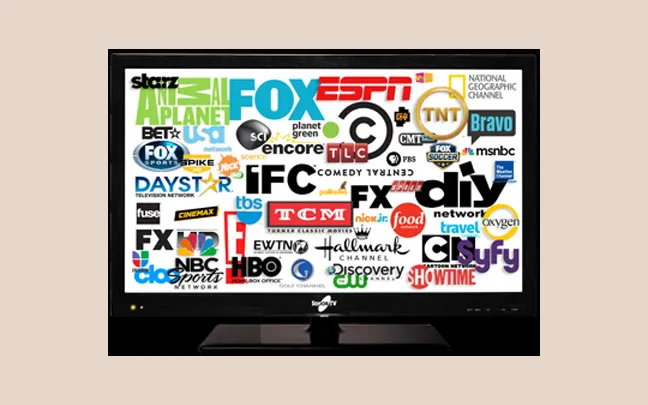
Cable television is a type of television broadcasting that is delivered via cable signals. It is a method of distributing television programming to consumers through a network of cables, satellites, and other communication systems. Cable television provides a wider range of channels and programming options than traditional broadcast television, and it has become a popular choice for many households.
Cable television works by using a cable network to transmit television signals from a broadcast center to individual homes or businesses. The signals are transmitted through a series of cables, which are connected to a cable box or a digital video recorder (DVR). The cable box or DVR decodes the signals and displays the programming on the television set.
Cable television offers a number of advantages over traditional broadcast television. It provides a wider range of channels and programming options, including specialty and premium channels along with pay-per-view services. It also offers higher picture and sound quality, and it allows viewers to control their viewing experience with features like pause, rewind, and fast forward.
In addition to traditional cable television, there are also newer forms, such as digital cable and streaming services. Digital cable offers a wider range of channels and services, including interactive features and on-demand programming. streaming services, such as Netflix and Hulu, allow viewers to watch television programming online, without the need for a traditional cable subscription.
Overall, cable television has become a popular choice for many households, offering a wide range of programming options and advanced features that are not available with traditional broadcast television.
History of Cable Television
The story of cable television unfolds like a captivating saga, filled with innovation, competition, and a profound transformation of home entertainment. Let's go through its timeline:
Early Seeds (1940s-1950s):
- The roots of cable TV sprouted in the 1940s when communities in mountainous areas, struggling with poor reception of over-the-air signals, built "community antenna television" (CATV) systems. These systems used large antennas to capture signals and distribute them via cables to subscribing homes.
- The 1950s saw further expansion of CATV, particularly in suburbs, but faced resistance from established broadcasters who feared competition.
Growth and Challenges (1960s-1970s):
- The 1960s witnessed a boom in CATV, reaching metropolitan areas and offering more than just improved reception. Channels dedicated to movies, sports, and local programming emerged.
- However, this expansion sparked legal battles with broadcasters, arguing that cable companies were infringing on their copyright by retransmitting their signals.
Rise of Cable Giants and Programming Revolution (1970s-1980s):
- In 1972, a landmark Supreme Court decision paved the way for cable's growth, setting regulations for retransmission rights. Enterprising entrepreneurs like Ted Turner capitalized on this opportunity.
- In 1980, Turner launched CNN, the first 24/7 news channel, revolutionizing news delivery and igniting a wave of competition. Channels like MTV and ESPN soon followed, diversifying the cable landscape.
Dominant Force and Evolution (1990s-Present):
- Cable emerged as the dominant television platform in the 1990s, offering superior picture quality, themed channels, and on-demand options. Major networks like HBO and Showtime gained prominence with original programming.
- The rise of the Internet in the 2000s brought new challenges. Online streaming services like Netflix and Hulu offered on-demand content and flexible subscriptions, leading to "cord-cutting" by some viewers.
- In response, cable companies adapted by bundling internet and phone services, investing in fiber optic infrastructure, and launching their own streaming platforms.
The Future of Cable TV:
- Cable TV navigates a changing landscape, facing fierce competition from online platforms and evolving viewer preferences.
- Embracing technological advancements like fiber optics, personalized content recommendations, and interactive features will be crucial for its future.
- Maintaining a diversified and high-quality channel lineup, offering competitive pricing, and exploring innovative partnerships could hold the key to cable's enduring relevance.
Key Features
Cable television, often shortened to cable TV, is a system for delivering television programming to viewers via coaxial cables or, in more recent advancements, fiber optic cables. It differs from traditional broadcast television, which transmits signals over the airwaves.
How it works:
- Cable companies build and maintain cable networks, laying cables underground or installing them on aerial wires.
- These cables carry television signals from a central location to individual homes or businesses.
- Subscribers pay a monthly fee to the cable company for access to the programming offered on the network.
Key advantages:
- Larger channel selection: Cable TV offers a much wider variety of channels compared to broadcast TV, typically ranging from major networks to niche channels focused on specific interests.
- Improved picture quality: Cable signals are generally less susceptible to interference than over-the-air signals, resulting in sharper and clearer picture quality.
- Additional features: Many cable providers offer additional services like on-demand programming, pay-per-view events, and high-speed internet access.
Different types of cable TV:
- Traditional cable: The most common type of cable TV, delivered through coaxial cables.
- Fiber optic cable: A newer technology offering faster internet speeds and potentially higher-quality video transmission.
- Satellite TV: Delivers signals via satellites orbiting the Earth, often used in areas with limited access to cable networks.
Challenges and future of cable TV:
- Competition from streaming services: Online streaming platforms like Netflix and Hulu are increasingly challenging cable TV for viewers, offering on-demand content and flexible subscription options.
- Cost considerations: While offering more channels and features, cable TV subscriptions can be more expensive than some streaming services.
- Cord-cutting: The trend of viewers cancelling their cable subscriptions and relying solely on streaming services is putting pressure on traditional cable providers.
Overall, cable television remains a major source of entertainment and information for millions of viewers worldwide. Despite facing competition from new technologies, it continues to evolve and adapt, offering a rich and diverse viewing experience.